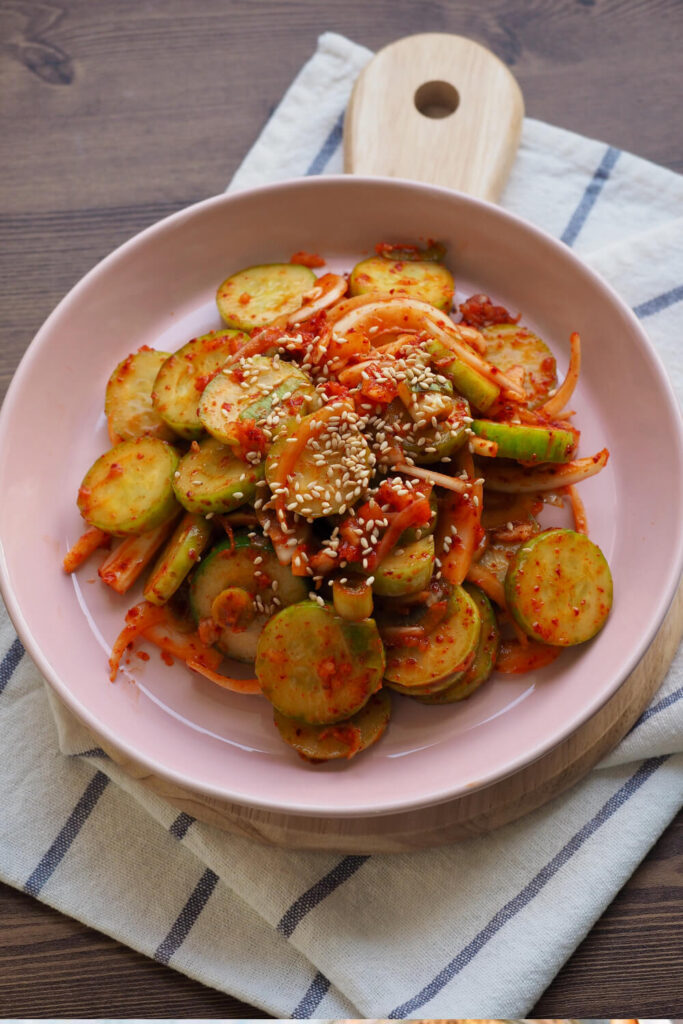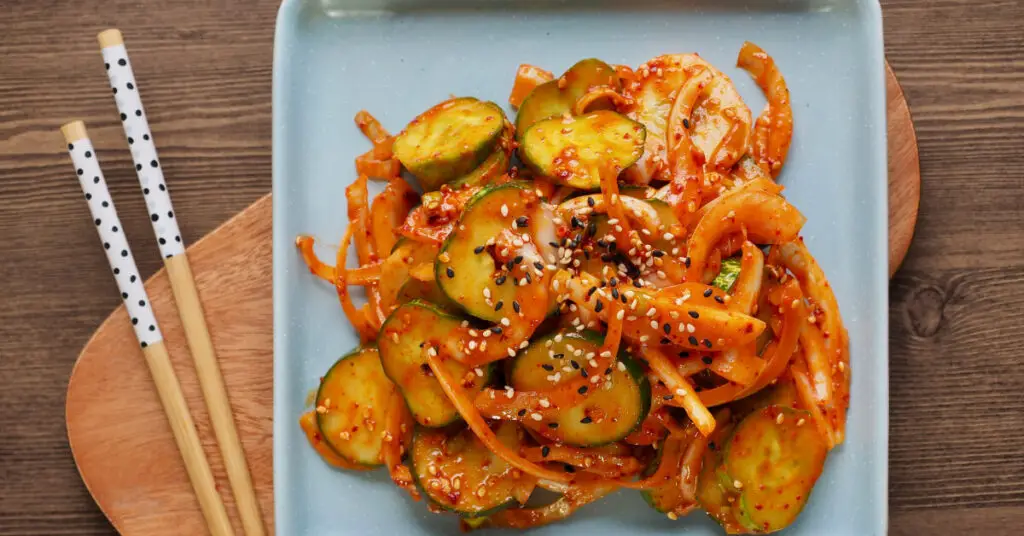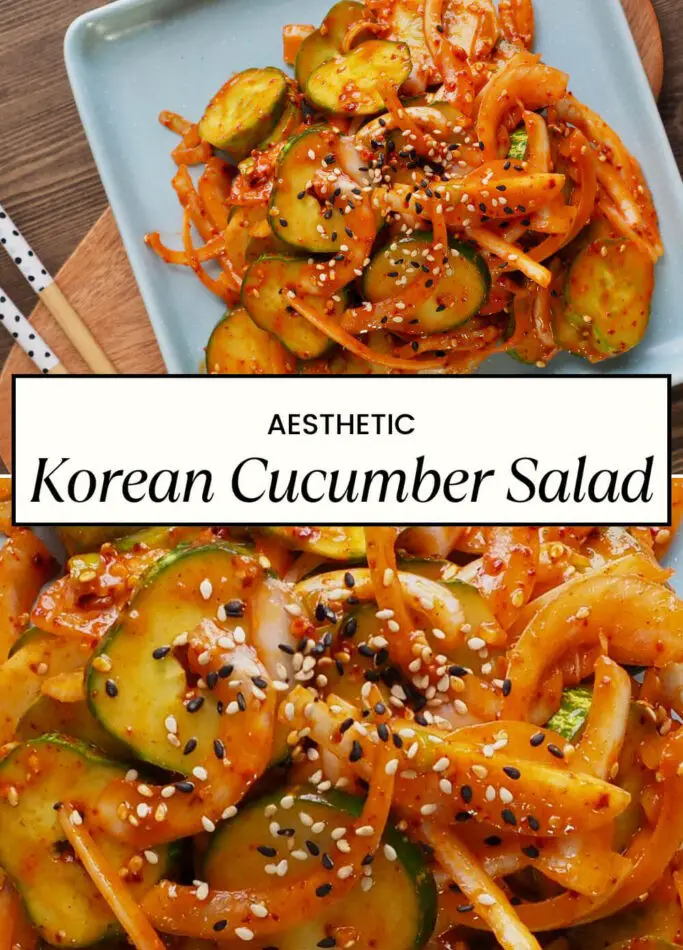Ingredients List
Here’s everything you’ll need to make this fresh and flavorful salad:
- 2 cucumbers (preferably Korean cucumbers or Persian cucumbers)
- 1 tablespoon sea salt
- 1 tablespoon gochugaru (Korean red pepper flakes)
- 1 tablespoon soy sauce (or tamari for gluten-free)
- 1 tablespoon rice vinegar
- 1 teaspoon sugar
- 2 cloves garlic, minced
- 1 teaspoon sesame oil
- 1 tablespoon sesame seeds
- 2 green onions, chopped
Timing
- Preparation time: 15 minutes
- Marinating time: 15 minutes
- Total time: 30 minutes
How to Make Korean Cucumber Salad: Step-by-Step Recipe
Step 1- Prepare the Cucumbers: Slice your cucumbers thinly, about ¼ inch thick. You don’t need to peel them, as the skin adds extra crunch.
Step 2- Salt the Cucumbers: Place the cucumber slices in a bowl and sprinkle with salt. Let them sit for 15 minutes. This draws out the excess moisture and keeps the salad crunchy.
Step 3- Make the Dressing: In a separate bowl, mix together gochugaru, soy sauce, rice vinegar, sugar, minced garlic, sesame oil, and sesame seeds.
Step 4- Assemble the Salad: Rinse the cucumbers well to remove excess salt, then pat them dry. Toss them with the dressing until fully coated.
Step 5- Garnish: Top with chopped green onions and extra sesame seeds. Serve immediately or refrigerate for later.

The Secret to Achieving the Perfect Crunch in Oi Muchim
The key to a crunchy cucumber salad lies in salting the cucumbers beforehand. This step draws out the water, leaving the cucumbers firm and crisp. After salting, don’t forget to rinse them thoroughly so the salad isn’t too salty. The crunchier your cucumbers, the better the salad.
Tips for Choosing the Best Cucumbers for This Recipe
Not all cucumbers are created equal. I’ve found that Korean cucumbers are the best, but if you can’t find them, Persian cucumbers or even English cucumbers work well. Just avoid larger cucumbers with thick skins, as they can be watery and less crunchy.
Customizing Korean Cucumber Salad: Spice Levels and Variations
You can easily adjust the spice level of this dish by adding more or less gochugaru. If you want a milder version, use half the amount of pepper flakes. You can also add carrots or even radishes for an extra layer of crunch and color. Sometimes, I throw in a splash of fish sauce for a deeper umami flavor.
Serving Suggestions: What to Pair with Korean Cucumber Salad
Oi Muchim pairs well with almost any main dish, especially grilled meats like Korean BBQ. It also goes great with rice dishes, dumplings, or even as a topping for a bibimbap bowl. Sometimes, I eat it on its own as a refreshing snack.
Make-Ahead and Storage Tips for Oi Muchim
This cucumber salad is best eaten fresh, but you can make it ahead and store it in the fridge for up to 2 days. Keep in mind that the cucumbers will lose a bit of their crunch the longer they sit, but the flavors will continue to develop.
Common Mistakes to Avoid When Making Korean Cucumber Salad
1- Skipping the salting step: If you don’t salt the cucumbers first, they’ll release too much water and make the salad soggy.
2- Using the wrong cucumbers: Larger, waxy cucumbers don’t absorb the flavors as well and can be too watery.
3- Over-marinating: Don’t let the cucumbers sit in the dressing for too long before serving, as they’ll lose their crispness.
How to Add Korean Cucumber Salad to Your Weekly Meal Prep
Oi Muchim is a fantastic make-ahead dish. You can prepare the cucumbers and dressing separately, then toss them together right before serving. It’s a great addition to lunchboxes, as it pairs well with proteins like grilled chicken or tofu.
Korean Cucumber Salad for Different Dietary Preferences: Vegan and Gluten-Free
This dish is naturally vegan, but if you’re gluten-free, make sure to use tamari instead of regular soy sauce. This simple swap ensures that the dish fits your dietary needs while keeping all the traditional flavors intact.
Health Benefits of Korean Cucumber Salad
Cucumbers are hydrating and low in calories, making this salad a great healthy option. The garlic and sesame seeds provide additional vitamins and minerals, while the gochugaru adds antioxidants. It’s a light, nutritious dish that satisfies both your taste buds and your body.
Nutritional Information (Per Serving)
- Calories: 60
- Carbohydrates: 8g
- Protein: 2g
- Fat: 3g
- Fiber: 2g
Conclusion
If you’re looking for a light, refreshing side dish that’s packed with flavor, Oi Muchim is the perfect recipe. It’s quick to make, easy to customize, and a healthy addition to any meal. I encourage you to give it a try and enjoy the fresh crunch of this Korean cucumber salad. You might just find yourself making it a regular part of your meal rotation, like I have.

